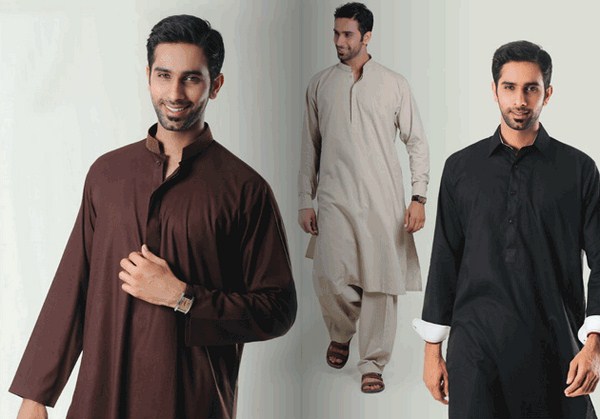Pakistani Salwar Kameez Biography
Source (google.com.pk)The trends of clothing in Pakistan have been affected greatly by western culture and Indian trends. The national dress of Pakistan is shalwar-kameez, but western dresses are more popular. Shalwar-Kameez are mostly worn and looked for during eastern events and occasions, such as Eid and weddings. A new trend I noticed on this Eid was that people bought accessories like shoes from online stores, which shows that online shopping trend is increasing in Pakistan.
Shalwars are like loose trousers that are available in a variety of styles and designs and kameez is a loose fitting and large tunic that is worn with loose shalwar. They are basically the same for both men and women with only a few differences in fittings and colors. Women also wear dupatta and they are more fitting conscious. That is why, even with the rising online shopping trend in Pakistan, women rely on offline shopping and go to malls and markets for shopping.
The national dress is Shalwar Qameez for both men and women. It consists of a long, loose fitting tunic with very baggy trousers. The dress is believed to be an amalgamation of the dresses worn by the ancient Persians, and Mughal Empire who have left their impression on the people and culture of Pakistan.
The men's version consists of solid, masculine colours, and is almost always accompanied by a collar and buttons (similar to a polo shirt). Men often wear an outer waistcoat over the shalwar kameez. The women's version almost never contains collar and buttons but is often embroidered and consists of feminine colors and may feature lace or flower patterns.In the summer, a light, cotton version is often worn, while during the winter, a heavier, wool version is worn.
The sherwani or achkan, with karakul hat is the recommended dress for male government employees and officials, as it is not specifically associated with any of the provinces. Most male government officials wear the formal black sherwani on state occasions.
A large Pakistani diaspora exists in the Western world and the Middle East. Whereas Pakistanis in the United States, Canada and Australia tend to be professionals, the majority of them in the United Kingdom, Germany and Scandinavia originally came from a rural background belonging to the working class. These emigrants and their children influence Pakistan culturally and economically, keeping close ties with their roots by travelling to Pakistan and especially by returning or investing there.See also: Economy of Pakistan
Pakistani girl in Mehndi Function wearing traditional Pakistani dress
Pakistan's service sector accounts for 53% of the country's gross domestic product. Wholesale and retail trade is 30% of this sector. Shopping is a popular pastime for many Pakistanis, especially among the well-to-do and the thirty-million strong middle class. The cities of Lahore, Karachi, Peshawar, Islamabad, Faisalabad, and Quetta are especially known for the great contrast in shopping experiences from burgeoning bazaars to modern multi-story shopping malls. In particular, Lahore and Karachi are peppered with colourful shopping plazas. Over 1,081 patent applications were filed by non-resident Pakistanis in 2004.
Pakistanis have evolved an often distinct and unique set of culture, traditions and customs in the region. Shalwar Qameez is the dress commonly worn, both by men and women, and Kashmiru, etc. put and dances are distinctly unique with their own melodies, instruments, patterns and styles. Pakistani arts in metal work, tiles, furniture, rugs, designs/paintings, literature, calligraphy, and much more are diverse and renowned internationally. Pakistani architecture is unique with its infusion of Islamic, Persian, Turkish and Indigenous styles. The manners and lifestyles are guided by a blend of traditions as well as the culture. Food dishes are also attracting quite a lot of attention with its wide blend of flavours and spices.
Pakistani Salwar Kameez Sherwani Designs 2014 For Groom By Manish Malhotra By Amir Adnan By Junaib Jamshed By Deepak Perwani Photos

Pakistani Salwar Kameez Sherwani Designs 2014 For Groom By Manish Malhotra By Amir Adnan By Junaib Jamshed By Deepak Perwani Photos

Pakistani Salwar Kameez Sherwani Designs 2014 For Groom By Manish Malhotra By Amir Adnan By Junaib Jamshed By Deepak Perwani Photos

Pakistani Salwar Kameez Sherwani Designs 2014 For Groom By Manish Malhotra By Amir Adnan By Junaib Jamshed By Deepak Perwani Photos

Pakistani Salwar Kameez Sherwani Designs 2014 For Groom By Manish Malhotra By Amir Adnan By Junaib Jamshed By Deepak Perwani Photos

Pakistani Salwar Kameez Sherwani Designs 2014 For Groom By Manish Malhotra By Amir Adnan By Junaib Jamshed By Deepak Perwani Photos

Pakistani Salwar Kameez Sherwani Designs 2014 For Groom By Manish Malhotra By Amir Adnan By Junaib Jamshed By Deepak Perwani Photos

Pakistani Salwar Kameez Sherwani Designs 2014 For Groom By Manish Malhotra By Amir Adnan By Junaib Jamshed By Deepak Perwani Photos
.jpg)
Pakistani Salwar Kameez Sherwani Designs 2014 For Groom By Manish Malhotra By Amir Adnan By Junaib Jamshed By Deepak Perwani Photos

Pakistani Salwar Kameez Sherwani Designs 2014 For Groom By Manish Malhotra By Amir Adnan By Junaib Jamshed By Deepak Perwani Photos

No comments:
Post a Comment